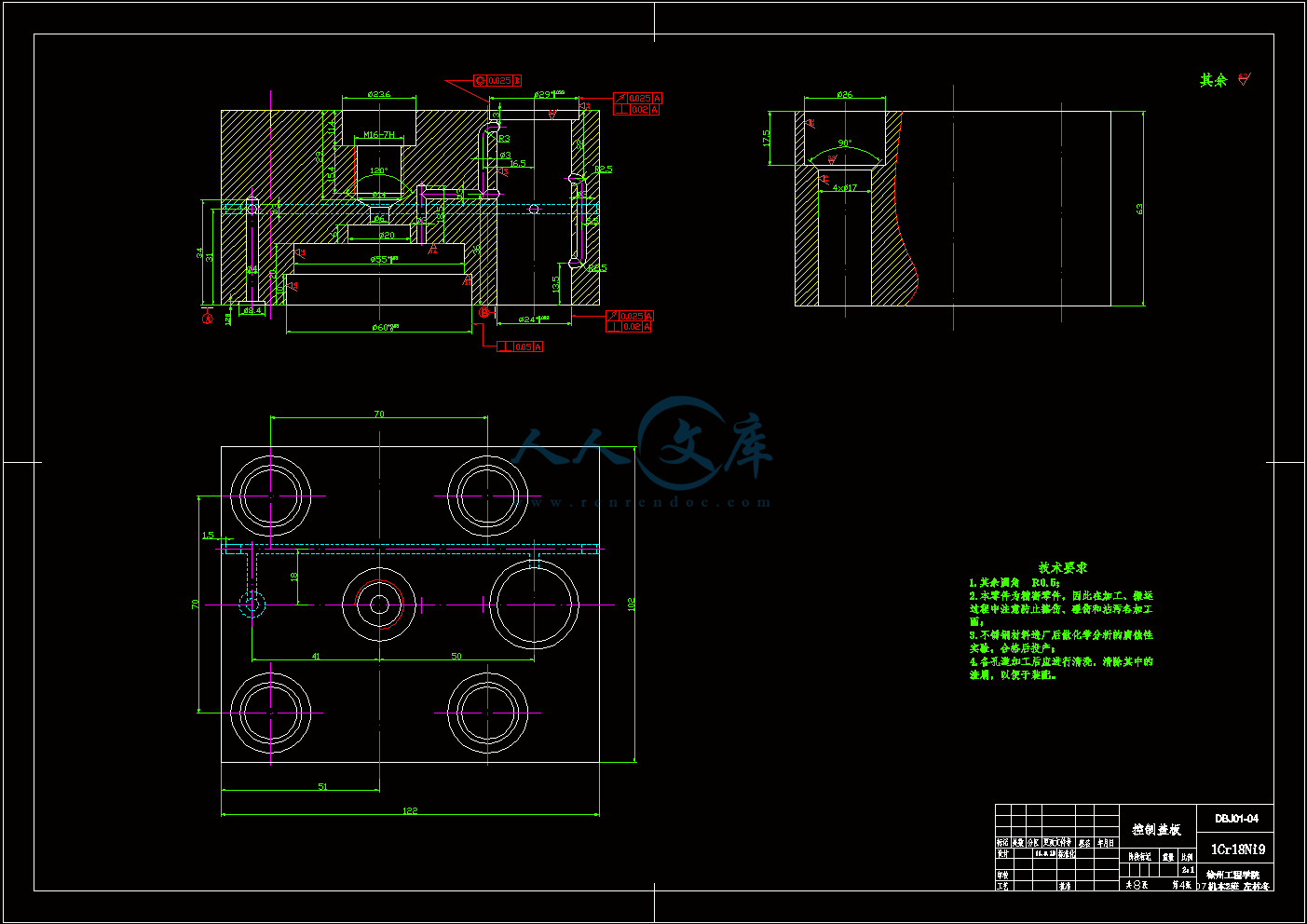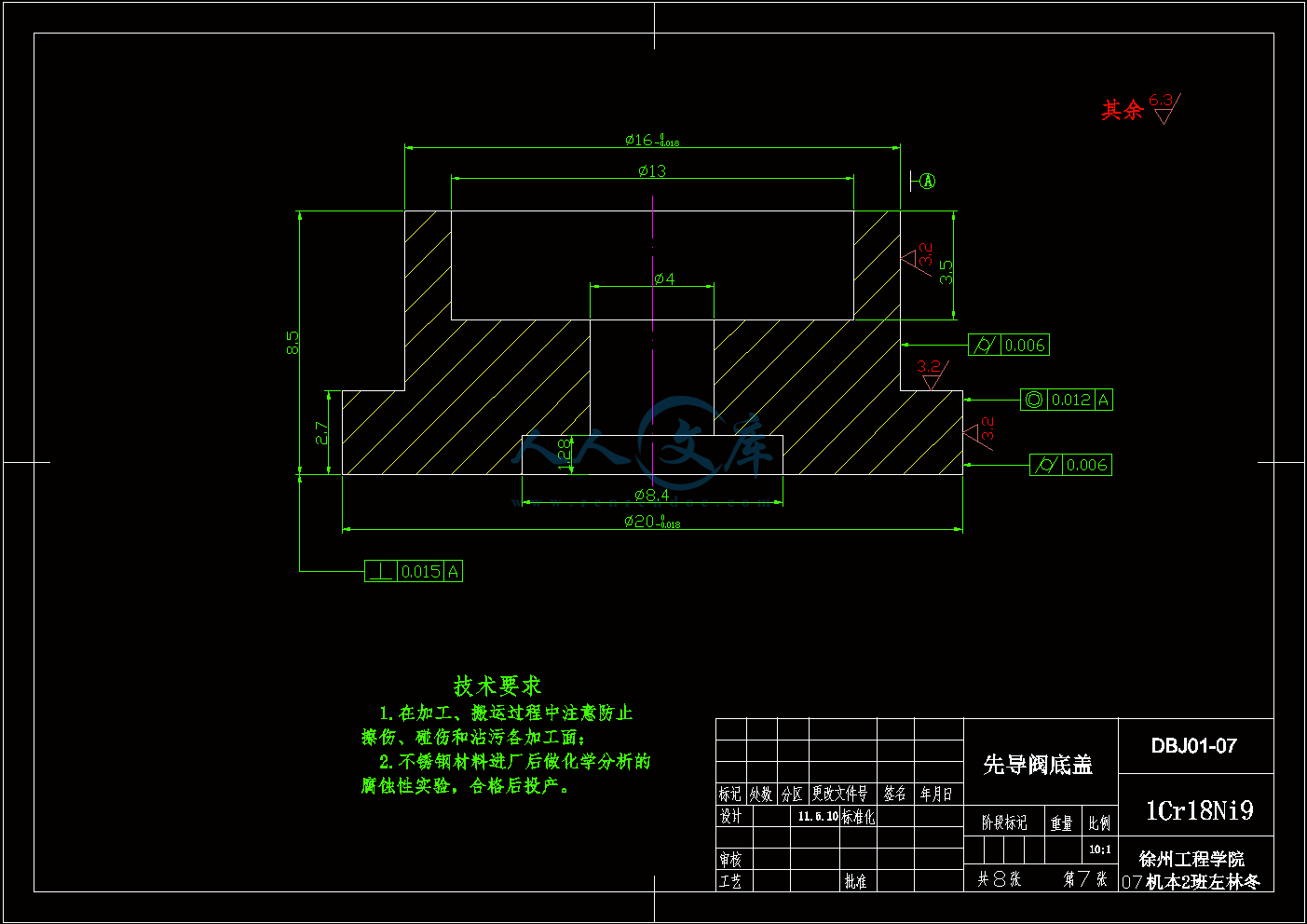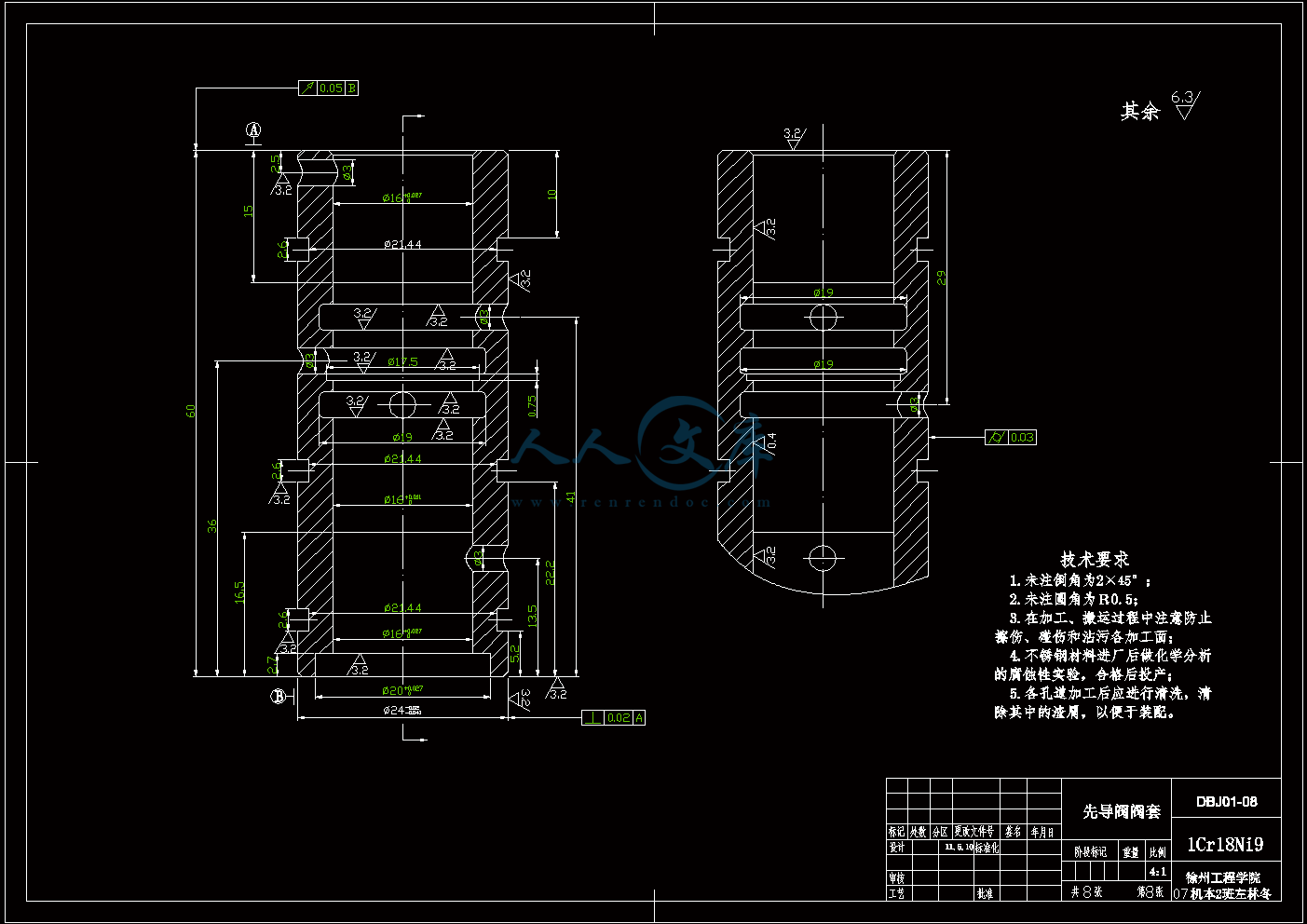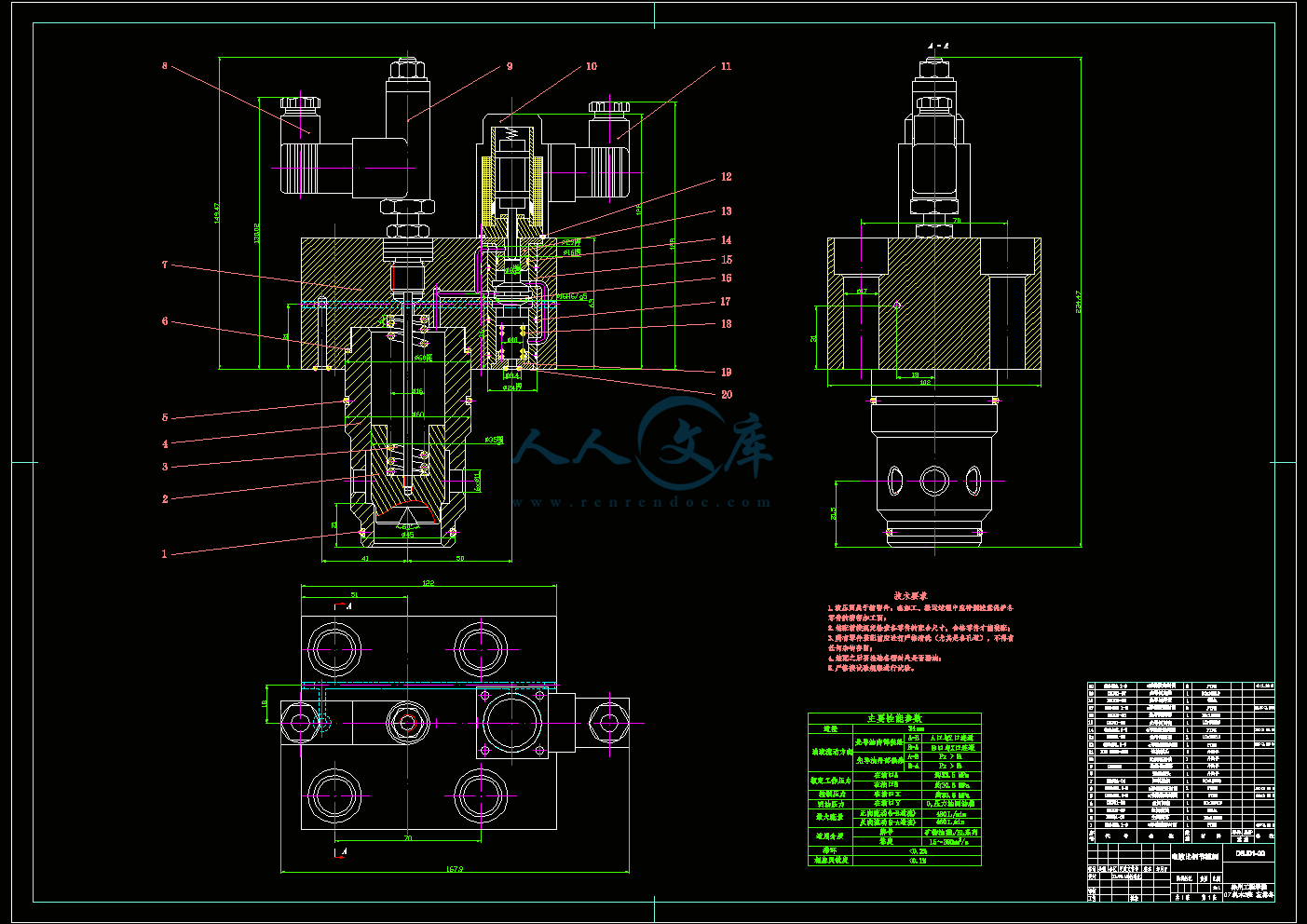带位移电反馈的二级电液比例节流阀设计
51页 28000字数+说明书+外文翻译+9张CAD图纸【详情如下】
DBJ01-01主阀阀芯A2.dwg
DBJ01-02先导阀顶盖A3.dwg
DBJ01-03主阀阀套A2.dwg
DBJ01-04控制盖板A1.dwg
DBJ01-05先导阀阀芯A2.dwg
DBJ01-06 通道块A1.dwg
DBJ01-07先导阀底盖A3.dwg
DBJ01-08先导阀阀套A2.dwg
DBJ01-00装配图A0.dwg
外文翻译--关于二级液压节流锥阀的低汽蚀研究.doc
带位移电反馈的二级电液比例节流阀设计说明书.doc











目 录
摘要I
AbstractII
1 绪论1
1.1 背景及意义1
1.1.1电液比例阀的发展阶段1
1.1.2电液比例技术在我国的发展状况1
1.1.3电液比例技术在国外发展境况2
1.2 电液比例阀的特点与分类2
1.3 设计参数4
2 流量阀控制流量的一般原理5
2.1 流量控制的基本原理5
2.2 流量阀的控制方式5
2.3 本设计中节流阀的参数5
2.4 主阀阀芯节流口形式确定6
3 比例节流阀结构设计7
3.1 插装阀介绍7
3.1.1 插装阀的组成7
3.1.2 插装阀的优点7
3.2 控制盖板的设计8
3.3 插装式主阀设计9
3.3.1 主阀阀套的设计9
3.3.2 主阀阀芯的设计11
3.3.3 插装式主阀面积比的确定12
3.3.4 主阀阀芯的受力分析13
3.4 先导阀设计17
3.4.1 减压阀的分类17
3.4.2 减压阀的工作原理18
3.4.3 先导阀阀芯详细受力分析20
3.4.4 先导阀溢流部分的设计23
3.4.5 先导阀的连接方式24
3.5 弹簧的选用24
3.5.1 主阀弹簧参数的确定24
3.5.2 先导阀弹簧参数的确定25
3.6 公差与配合的确定25
3.7 比例放大器26
3.7.1 比例放大器的分类26
3.7.2 电液比例控制元件对比例放大器的要求27
3.7.3比例放大器的基本控制电路27
3.8 比例电磁铁28
3.8.1 电- 机械转换器分类28
3.8.2 比例电磁铁29
3.8.3 比例电磁铁的分类29
3.8.4 比例电磁铁应满足的要求30
3.8.5 比例电磁铁的位移-力和电流-力特性30
3.8.6 比例电磁铁位移-力特性的实现原理31
3.9 结构设计小结31
4 节流阀工作总原理分析及其性能参数指标32
4.1原理分析32
4.2 静态性能指标33
4.3 动态性能指标34
5电液比例控制系统35
5.1 反馈的概念35
5.2 闭环控制与开环控制35
5.3 电液比例控制系统的组成36
5.4 电液比例控制系统的特点37
5.5 比例控制系统的分类37
5.6 比例控制系统的发展趋势38
5.7 小结38
6 利用UG进行运动仿真39
结论43
致谢44
参考文献45
1 绪论
1.1 背景及意义
1.1.1电液比例阀的发展阶段
比例控制技术产生于20世纪60年代末,那时的电液伺服技术已日趋完善,由于伺服阀的快速响应及较高的控制精度,以及明显的技术优势,伺服阀迅速在高精度、快速响应的领域中,如航天、航空、轧钢设备及实验设备等中取代了传统的机电控制方式。但由于电液伺服阀成本高、应用和维护条件苛刻,难以被工业界接受。在很多工业应用场合并不要求太高的控制精度或响应性,而要求发展一种廉价、节能、维护方便、适应大功率控制及具有一定控制精度的控制技术。这种需求导致了比例技术的诞生并促进了其发展。而现代电子技术和测试技术的发展为工程界提供了可靠而廉价的检测、校正技术。
1967年瑞士Beringer公司生产的KL比例复合阀标志着比例控制技术在液压系统中应用的正式开始,主要是将比例型的电- 机械转换器(比例电磁铁) 应用于工业液压阀。比例技术的发展大致可分为以下三个阶段:
(1)从1967年瑞士Beringer公司生产Kl比例复合阀起,到70年代初日本油研公司申请了压力和流量两项比例阀专利为止,标志着比例技术的诞生时期即第一阶段。
(2) 1975年到1980年间,采用各种内反馈原理的比例元件大量问世,耐高压比例电磁铁和比例放大器在技术上也日趋成熟。可以认为比例技术的发展进入了第二阶段。
(3) 80年代,比例元件的设计原理进一步完善,采用了压力、流量、位移内反馈、动压反馈及电校正等手段,使阀的稳态精度、动态响应和稳定性都有了进一步的提高。比例技术的发展进入了第三阶段。
电液比例阀是以传统的工业用液压控制阀为基础,采用模拟式电气-机械转换装置将电信号转换为位移信号,连续地控制液压系统中工作介质的压力、方向或流量的一种液压元件。此种阀工作时,阀内电气-机械转换装置根据输入的电压信号产生相应动作,使工作阀阀芯产生位移,阀口尺寸发生改变并以此完成与输入电压成比例的压力、流量输出。阀芯位移可以以机械、液压或电的形式进行反馈。
1.1.2电液比例技术在我国的发展状况
我国电液伺服技术始于上世纪六十年代,到七十年代有了实际应用产品,目前约有年产能力2000台;电液比例技术到七十年代中期开始发展,现有几十种品种、规格的产品,约形成有年产能力5000台。但是总的来看,我国电液伺服比例技术与国际水平比有较大差距,主要表现在:缺乏主导系列产品,现有产品型号规格杂乱,品种规格不全,并缺乏足够的工业性试验研究,性能水平较低,质量不稳定,可靠性较差,以及存在二次配套件的问题等,都有碍于该项技术进一步地扩大应用。
基于以上所述,本设计将对电液比例阀中的一类——二级电液比例节流阀进行设计。该阀的功率级为二通插装阀,先导级为电液比例三通减压溢流阀。
1.1.3电液比例技术在国外发展境况
在国外,近年来比例阀出现了复合化的趋势,很大地提高了比例阀(电反馈) 的工作频宽。所以在基础阀的基础上,其他一些国家发展出了先导式电反馈比例方向阀系列,它与定差减压阀或溢流阀的压力补偿功能块进行组合,构成电反馈比例方向流量复合阀,可进一步取得与负载协调和节能效果。
随着微电子技术和数学理论的发展,国外比例阀技术已达到比较完善的程度,已形成完整的产品品种、规格系列,并对已成熟的产品进一步扩大应用,在保持原基本性能与技术指标的前提下,向着简化结构、提高可靠性、降低制造成本及“四化”(通用化、模块化、组合化、集成化)的方向发展,以实现规模经济生产,降低制造成本。
由此可见我国的电液比例技术与国际上海存在着很大的差距,我国的科技人员还要继续努力才能不被国际市场淘汰。
1.2 电液比例阀的特点与分类
比例阀把电的快速性、灵活性等优点与液压传动力量大的优点结合起来,能连续地、按比例地控制液压系统中执行元件运动的力、速度和方向,简化了系统,减少了元件的使用量,并能有效的防止在压力或速度变换时产生冲击现象。比例阀主要用在没有反馈的回路中,对有些场合,如进行位置控制或需要提高系统的性能时,电液比例阀也可作为信号转换器与放大元件组成闭环控制系统。
比例阀与开关阀相比,比例阀可以简单地对油液压力、流量和方向进行远距离的自动连续控制或程序控制,而且响应快, 工作平稳,自动化程度高,容易实现编程控制,控制精度高,能大大提高液压系统的控制水平。与伺服阀相比,电液比例阀虽然动静态性能差些,但使用元件较少,结构简单,制造比电液伺服阀容易,价格低,效率也比伺服阀高(伺服控制系统的负载压力仅为供油压力的2/3),系统的节能效果好,但使用条件、保养和维护与一般液压阀相同,可以大大地减少由污染而造成的工作故障,从而提高了液压系统的工作稳定性和可靠性。
比例控制元件的种类繁多,性能各异,有多种不同的分类方法。
(1) 按液压放大级的级数来分,又可分为直动式和先导式。直动式是由电一机械转换元件直接推动液压功率级。由于受电一机械转换元件的输出力的限制,直动式比例阀能控制的功率有限,一般控制流量都在15L/min以下。先导控制式比例阀由直动式比例阀与能输出较大功率的主阀级构成。前者称为先导阀或先导级,后者称主阀功率放大级。根据功率输出的需要,它可以是二级或三级的比例阀。二级比例阀可以控制的流量通常500L/min以下。比例插装阀可以控制的流量达1600L/min.
 川公网安备: 51019002004831号
川公网安备: 51019002004831号